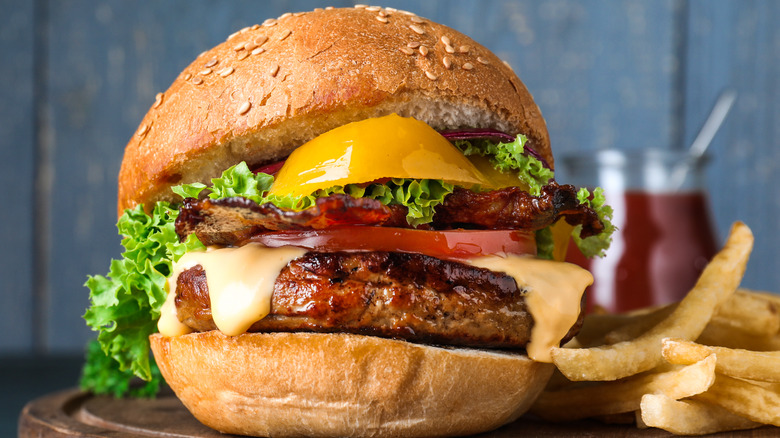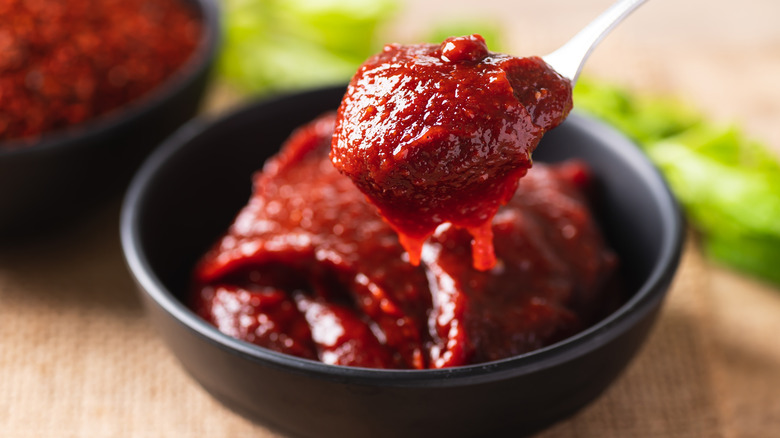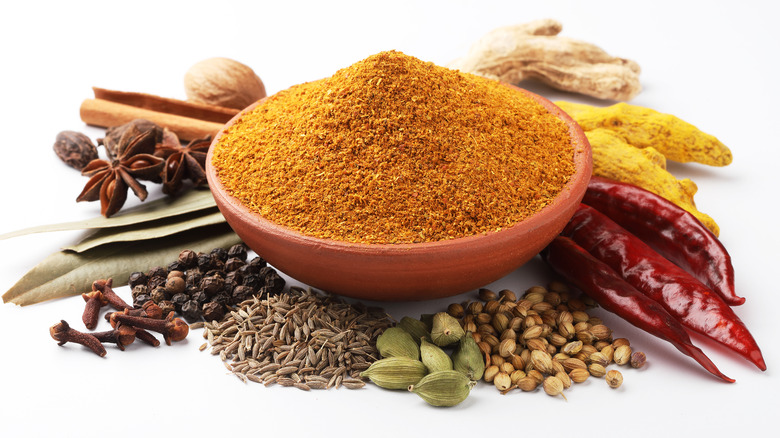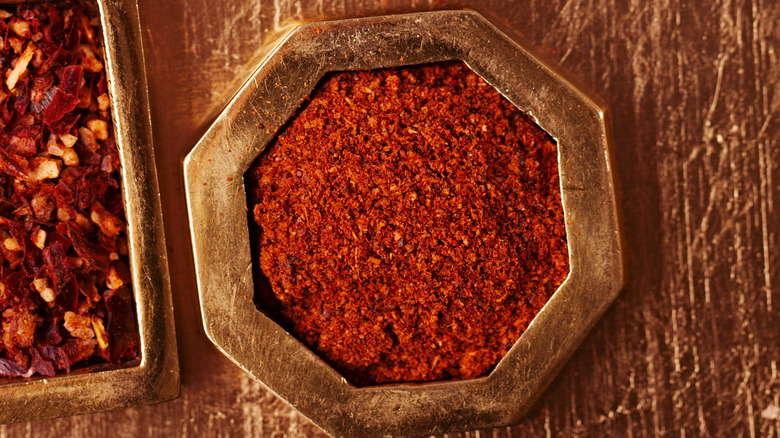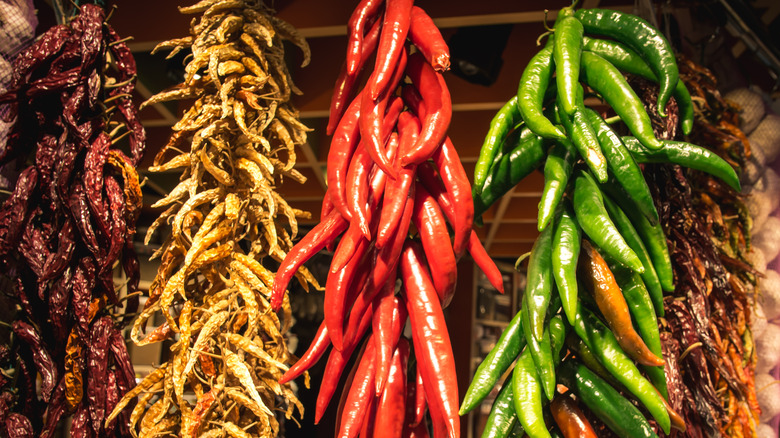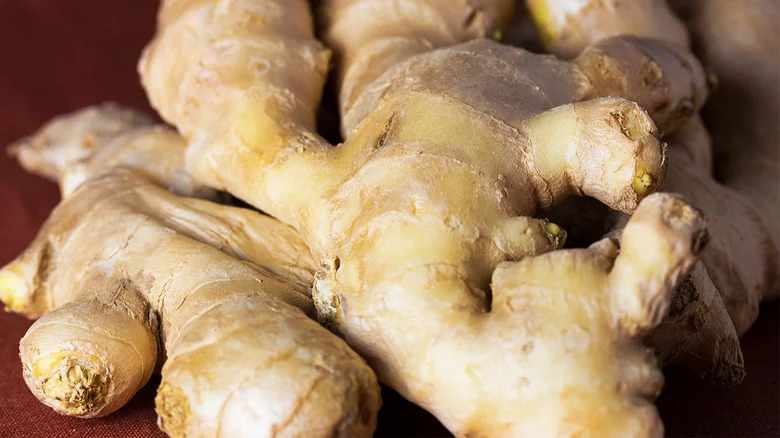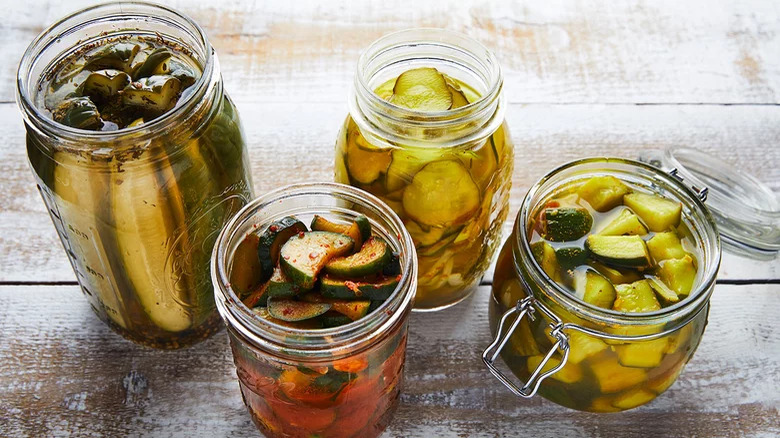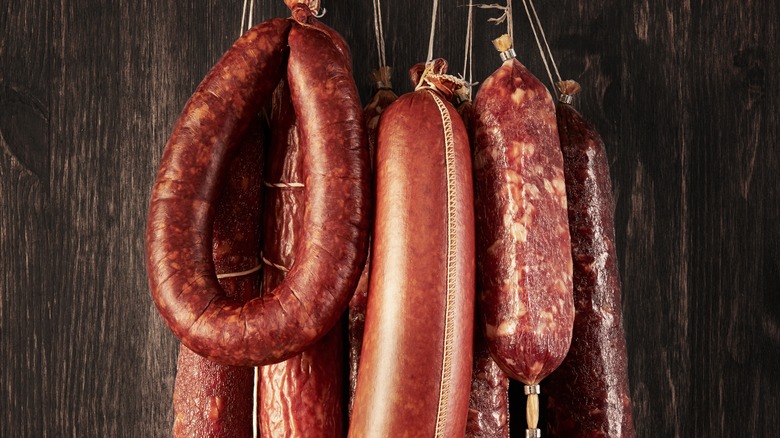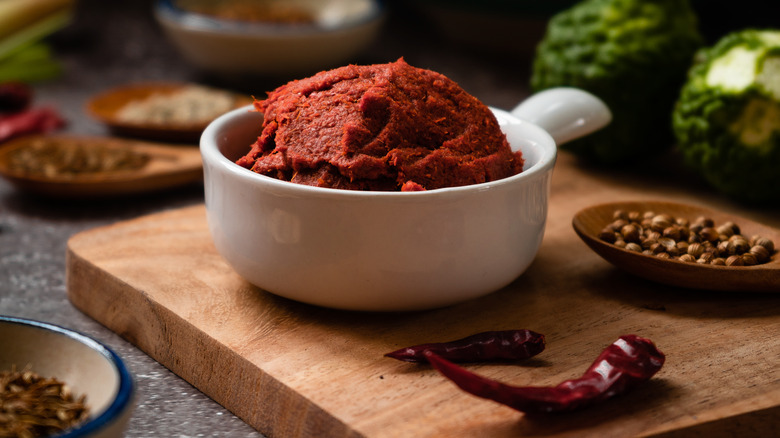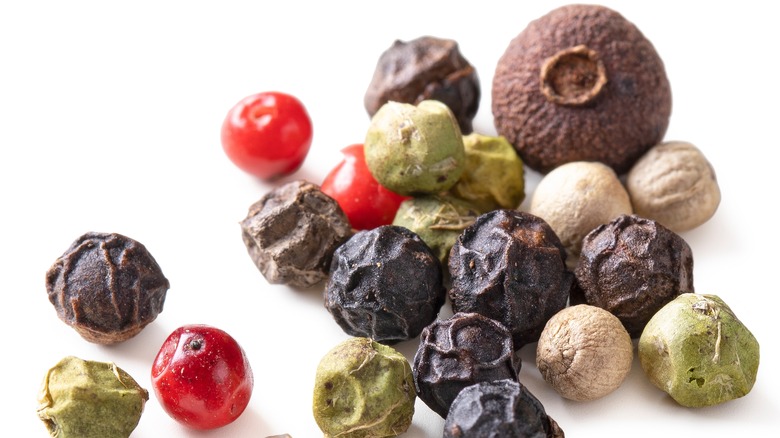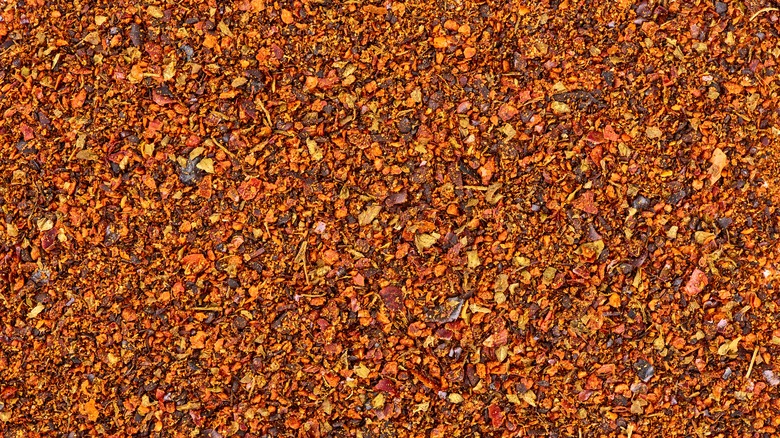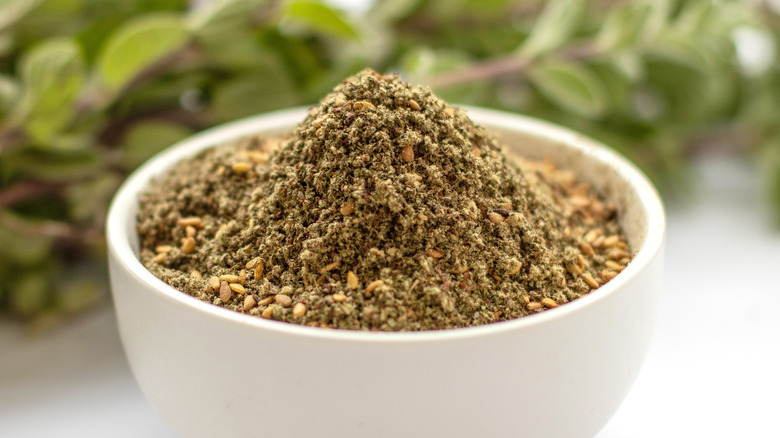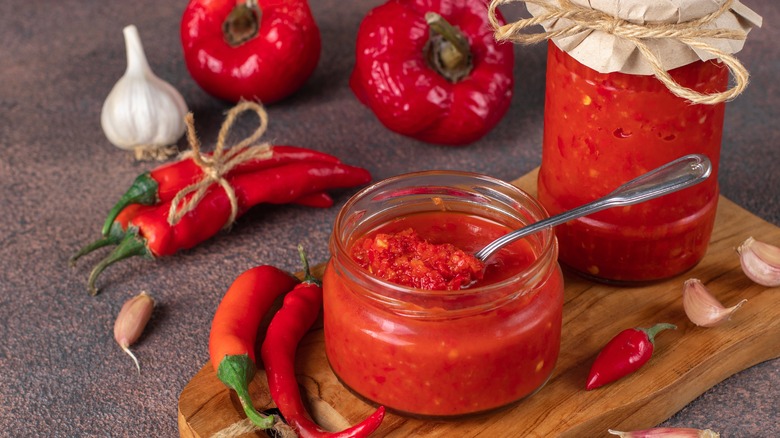12 Best Mix-Ins To Seriously Spice Up Your Burger
In his 2005 book "Hamburgers & Fries: an American Story," John T. Edge picks at the origin myth and the journey of the burger. The popular telling describes the burger's evolution from a mobile meal for the Mongol army to its refinement to steak tartare after conquering Moscow. The legend continues, describing German sailors bringing the dish to Hamburg. There, sailors' wives couldn't abide by the crude atrocity of tartare and started cooking the beef, placing it between slices of bread to become known as the "Hamburg steak." While many believe and want that story to be accurate, it isn't. Edge explains that while the Hamburg name is correct, burger-like foods in conflicting periods disprove the legend.
Edge retells the burger war story of the first part of this century. Chefs like Daniel Boulud, Ferran Adria, and Claude Troisgros sought to elevate the humble burger, utilizing Kobe beef, adding foie gras, and showering them with truffles in a prolonged game of oneupmanship. The inevitable backlash came, with the next generation of chefs eschewing the mindset that salt, meat, and heat couldn't produce a transcendent burger experience, and simplicity again reigned.
We can now safely stand in the middle ground, appreciating elevation and simplicity. Equipped with a pantry of spices, we can lift a humble burger without the artifice and excess of goose liver. Keep in mind that "spice" doesn't explicitly imply "heat" as we take a look at how to spices to take your burger to the next level.
Gochujang
Gochujang is a fermented blend of dried chiles, soybeans, salt, and glutinous rice, and a backbone ingredient for many Korean dishes either as a cooking ingredient or condiment. The fermentation creates an unctuousness that boosts umami, the elusive-to-define depth of flavor that enhances the taste and the feeling of richness on your tongue. Because of its paste consistency, you can fold it directly into your meat (or meat substitute) without adverse textural or structural effects.
Adding the paste should be approached with one caveat, though. Because gochujang undergoes fermentation the same way as miso, the starches in the rice undergo hydrolysis and convert to maltose and dextrose sugars. Sugar burns around 350 degrees Fahrenheit, so care should be given to exposing the burgers to high-temperature, direct heat.
Umami aside, the fermentation lends funkiness to the paste, and the salt level necessary to control bacterial growth during fermentation remains in the finished product. If these flavors are not for you, the base chile ingredient, gochujaru, can add the heat and fruitiness of gochujang without the funk or residual salt of fermentation. Simply fold the ground spice into your meat, as with the gochujang, as sprinkling it onto your burgers can lead to scorching the chile.
Masala
At first glance, adding a distinctly Indian spice mix to beef might seem somewhat odd. But, in the southern Indian state of Kerala, beef is a common ingredient. Kerala masala, or "meat masala," lends itself particularly well to beef, lamb, and chicken. Masala refers to a blend of spices, of which versions more commonly known in Western cultures, like garam masala or tikka masala, are a subset. Recipes for meat masala vary but commonly contain coriander seeds, cumin, red chiles, turmeric, black pepper, dried ginger, mustard seeds, fennel seeds, garlic, cinnamon (or cassia,) fenugreek cardamom, cloves, nutmeg, and mace.
Garam masala contains similar ingredients, adding star anise and removing fennel, fenugreek, turmeric, and mace. They have the same building blocks but diverging flavor profiles. What they have in common is a deep savory element balanced with brighter components, such as ginger and cardamom, creating not only complexity but a balance of flavors. As with gochujang, it's better to fold the masala into your meat to avoid high-temperature scorching and your burgers tasting of little but burnt spice.
Berbere
Berbere, an Ethiopian spice blend, is a flavoring component of many stews and soups in the area. As you'll see in further discussions, recipes for many spice blends are far from standardized, veering according to available ingredients and, sometimes, personal preference. Chef Marcus Samuelson builds his berbere from coriander seeds, fenugreek, black peppercorns, cardamom, garlic, allspice, dried onion, chiles de árbol, paprika, cinnamon, ginger, and nutmeg. Toast them over low heat and grind them together to complete the process. The observant may see some commonality in core ingredients and draw lines that connect "meat masala," berbere, and Jamaican jerk spice.
The chiles definitely add heat to the mixture, so if you're capsaicin averse, you can tone down the number of chiles in the recipe. Heat aside, the berbere adds pungent depth balanced with brightness from the coriander, cardamom, and ginger. It's worth mentioning that berbere is best mixed into the meat rather than sprinkled onto it to avoid scorching.
Chiles
Gordon Ramsay folds grated, frozen fresh chiles into his ground beef when making his signature burger. Grating the frozen chiles ensures fine, more uniform pieces that will better distribute through your burger meat while avoiding large, surprising chunks of chile heat. If you're confident in your knife work, you can forgo the freezing and grating ritual and simply fine-chop them.
The world of chiles is vast, and you can use any variety of chiles according to your preference and heat tolerance. We don't have the bandwidth for a thorough examination of all chiles, let alone all New World varieties, but we'll examine some for their flavor profiles and what they bring to the party beyond heat.
Serranos and jalapeños both have an earthy, grassy taste, with the serrano packing two to five times the heat level of the jalapeño, and both are best utilized finely diced or grated. Ancho chiles have a raisiny flavor with a low Scoville rating that can richen your burger and are best ground after removing the seeds. Calabrian chiles are sweet, fruity, and hot and can be used fresh or canned, and their dried seeds are the origin of red pepper flakes in Italian cooking.
Ginger
Ginger and beef (let's not forget chicken or pork) are ubiquitous pairings in many East-Asian cuisines. So why not pair it with a burger? Ginger can be a standalone addition or paired with other traditionally complementary flavors like soy, sesame, and garlic.
You can also stray from the East Asian pantry and look at the flavor profiles of European meats and sausages, such as British bangers, made with sage, nutmeg, and white pepper. Ginger and heat play well together, whether that heat comes from chiles or black pepper. Various herbs also enjoy playdates with fresh ginger, like rosemary for an earthy note or mint for bright vegetal-ness. Fennel fronds (or ground seeds, but those are technically a spice), tarragon, or chervil lend a licorice flavor that bounces off the ginger quite nicely.
When cooking with ginger, you want a little heat to activate it, but overcooking it will turn its pungent, stinging flavor into a sweet, aromatic compound like that found in gingerbread. So, once again, it's best to fold it into your burger meat to protect it from direct heat.
Pickled things
Depending on your taste, pickles may be a perfect topping for your burger – or not. For those who like them, moving the pickles inside the meat adds texture while letting the vinegary and spice-laden flavor permeate the patty. With cucumber pickles, you'll find many spices we've already discussed, like coriander, clove, and cinnamon, in their brine. You can shake up your mix with different types of cucumber pickles, such as garlic or bread and butter instead of dill.
You can also take the tart flavor profile in other directions with other pickled items. Kimchi, specifically the baechu made with napa cabbage that people in the US are most familiar with, adds texture and flavor, circling back to gochujang, among other ingredients. Not feeling cucumbers or Korean flavors? Okra or sauerkraut can bring that tart, fermented funkiness to the table while lending a less-crunchy texture.
Whatever flavor of pickled thing you're considering, keep the following in mind. First, chop your pickled ingredients into small pieces to not interfere with the structure of the burger. Second, water interferes with the Maillard reaction, which, in this case, we are using to refer to the browning of the meat. Excess water will leave you with a grey, steamed burger rather than one with a browned, crusty exterior. To avoid this, drain your pickled ingredients in a colander while weighing them down with a plate for about 10 minutes to extract any excess water before folding them into your burger meat.
Sausage, ham, or bacon
Pork products such as sausage, ham, or bacon can add extra flavor and moisture to your burger. Here, Aarón Sanchez mixes ground beef and Mexican chorizo at a 1-to-1 ratio, although you could tweak that ratio to as much as 3-to-1 ground beef to sausage. Using those ratios, you could expand to using other sausages, such as Italian hot fennel, banger, or even morcilla.
Because the idea is to add moisture, we don't recommend adding dried sausages to your burger. Spanish-style chorizo or other dried salume, which would also apply to dried hams, such as prosciutto or country ham, add flavor, but their moisture content is too low. But undried ham or deli meats that contain significant water content — such as capicola, mortadella, or bologna — would fit the bill for adding moisture and flavor. Thinking logically, bacon, in its various forms, like pepper or maple bacon, pancetta, back bacon, or guanciale, could be used in the same ratio of meat to bacon.
Whatever product you decide on, grind your pork to a similar texture as your burger meat and fold it directly into the mix.
Curry
With a proliferation of beef curries from multiple cultures, it's safe to say that curry burgers are a pairing that doesn't wander far afield from norms. Far from limited to the yellow or Madras curry powders, curries span the Asian continent, with wet and dry variations. Green, yellow, or red Thai curry pastes are packed with many of the spices we covered in sections above, like masala, but then livened with the addition of galangal, fresh ginger, chiles, and sometimes lemongrass and shrimp paste. Amanda Cohen's green curry paste recipe is flavorful, vegan, and vegetarian-friendly for plant-based burger enhancement and is a good replacement for canned for those with shellfish allergies.
Japanese curry powder also has familiar ingredients like turmeric, coriander, and fenugreek, but the addition of bay leaf, citrus peel, and sage contributes brighter and earthier notes to the mix. Korean curry powder, meanwhile, sits in the middle between Indian curry powder and Japanese in terms of spice flavor. Do keep in mind that spice does not necessarily imply heat, especially in this case where we are speaking of the degrees of spices added to the powder.
Peppercorns
As the backbone of steak au poivre, peppercorns translate from steak to burgers quite well. With three commonly-encountered types and multiple sub-types of each, you can create a range of flavor profiles with these berries.
Outside of the white-label "black peppercorns" sold in grocery stores, the two you'll find most frequently are tellicherry and lampong. When you want a smoky, floral heat with your burger, these are all good choices. You can fold them into your meat or grind them directly onto the burger surface AFTER searing your patties to avoid scorching the pepper.
White peppercorns are more heat-forward than black and are commonly found alongside cayenne as a heat component of "Cajun seasoning". They're also found throughout European cooking in dishes like banger sausages. Follow the same methods as black peppercorns for best results in using white pepper.
Green peppercorns have a fruitier, more aromatic quality than black or white. They're the fresh berry that produces both varieties and are commonly found canned or jarred. Because they're not dried, they're softer than the other two varieties. Crush them with the flat of a knife or under a skillet before folding them into the burger meat.
Baharat
Baharat is a spice blend commonly found in the eastern Mediterranean region. Translated from Arabic, it roughly means "spicy," and ingredients and proportions vary from region to region and even differ among households, often with families having their unique proprietary blend. The most commonly encountered ingredients are black pepper, cardamom, cloves, cumin, nutmeg, coriander, and paprika, leading the mix to skew towards a balance of bright and earthy flavors. The cardamom and coriander add brightness, while the black pepper brings a smoky heat to contrast and accent the other ingredients' deeper, earthy tones.
If you're picking up on commonalities, you might see that Baharat has much in common with meat masala, berbere, and some curries mentioned previously. Mixing different proportions of similar ingredients results in distinctly different flavor profiles, each of which can be effective with your burger meat, whatever protein or meat substitute you choose to make them from.
Za'atar
Another herb and spice blend from the eastern Mediterranean area, za'atar is more earthy in flavor thanks to herbs like marjoram, oregano, and thyme, but also brightened with sumac and sometimes orange zest. While it may lack heat, this blend adds pungency punctuated with floral and citrus flavors to your meat.
Za'atar has many intended uses as a condiment or garnish before using it with meat. In this example, the Olive Oil Times infuses olive oil with the blend as both a garnish and a condiment for labneh. This recipe provides a good segue opportunity for the second reason we recommend mixing dried spices into your meat.
Fats and heat activate dried spices and herbs more so than simply using them in their natural state. Terpenes and essential oils found in herbs and spices that are made more pungent when heated in fat, the source of which in this case is your burger and your grill. If you do not want to place it in your burger, you can always mix it with olive oil and toast it on your buns while the burgers cook.
Adjika
This Georgian pepper paste is another blend that varies with the maker and location. Typically, adjika consists of garlic, tomato, chiles, coriander, fenugreek, vinegar, and salt, although some recipes call for such wide-ranging ingredients as apples for roundness and body. Balancing the heat with sweet, tart, and spicy elements that add richness to the paste, the combined ingredients accent and contrast the savory qualities of burgers, whether beef, chicken, pork, lamb, or meat substitutes.
While adjika is traditionally used as a condiment, folding it into your burger allows the flavor of the adjika to permeate the meat rather than simply sitting on top of it. As we discussed with gochujang, both tomatoes and chiles (and apples, if the recipe contains them) contain a significant amount of sugar, which will burn at low temperatures. So, folding them into the meat is recommended, as is exercising caution with high-temperature direct heat.
